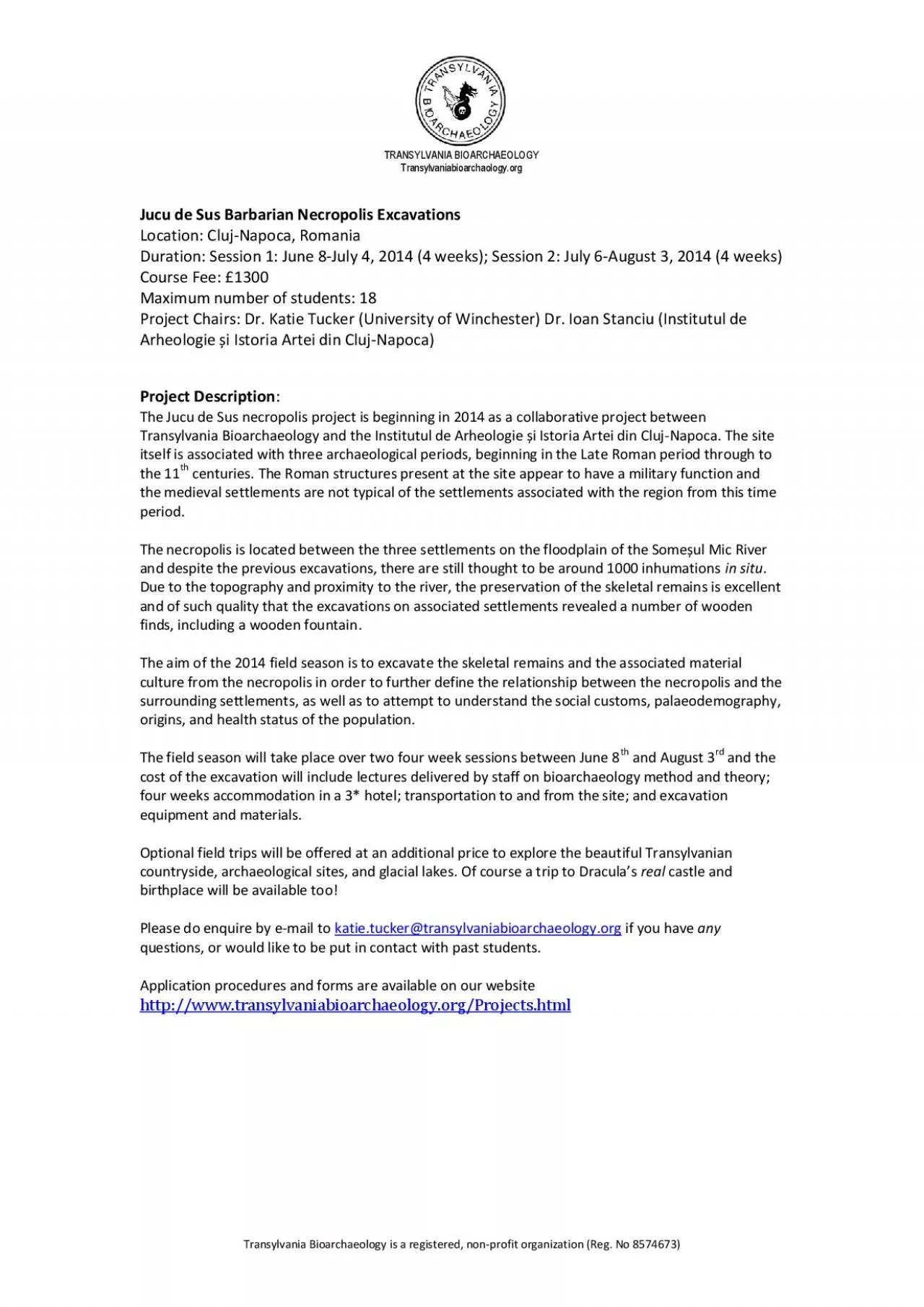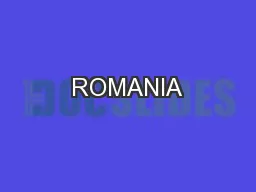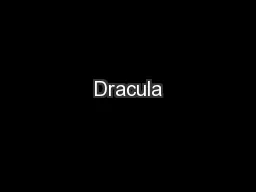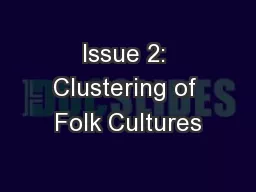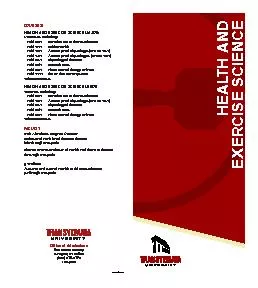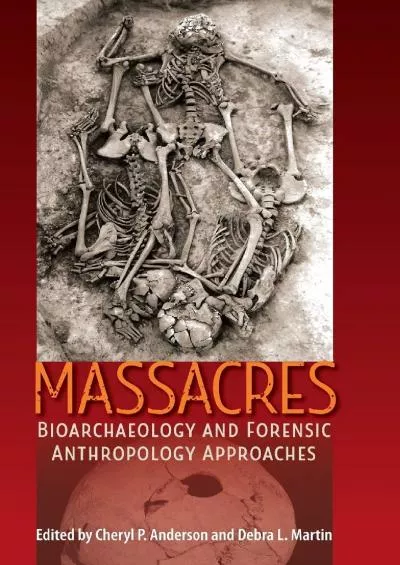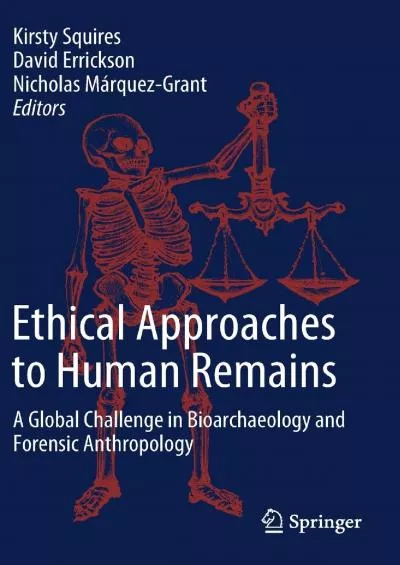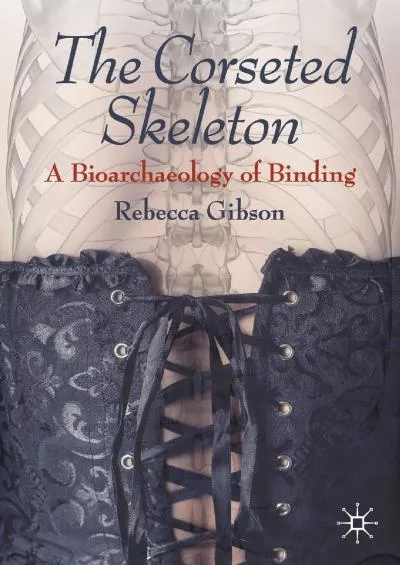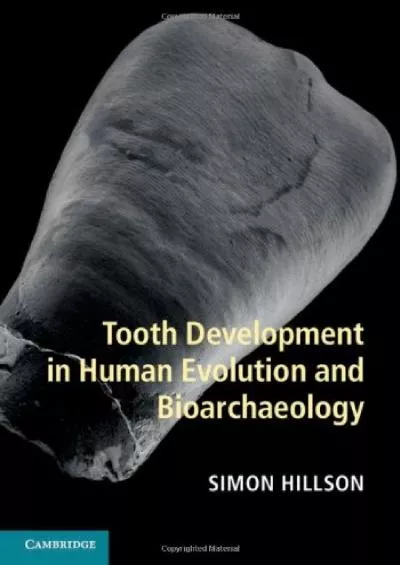PDF-TRANSYLVANIA BIOARCHAEOLOGY
Author : paige | Published Date : 2021-03-17
Transylvaniabioarchaologyorg Transylvania Bioarchaeology is a registered non profit organization Reg No 8574673 Jucu de Sus Barbarian Necropolis Excavations Location
Presentation Embed Code
Download Presentation
Download Presentation The PPT/PDF document "TRANSYLVANIA BIOARCHAEOLOGY" is the property of its rightful owner. Permission is granted to download and print the materials on this website for personal, non-commercial use only, and to display it on your personal computer provided you do not modify the materials and that you retain all copyright notices contained in the materials. By downloading content from our website, you accept the terms of this agreement.
TRANSYLVANIA BIOARCHAEOLOGY: Transcript
Transylvaniabioarchaologyorg Transylvania Bioarchaeology is a registered non profit organization Reg No 8574673 Jucu de Sus Barbarian Necropolis Excavations Location Cluj Napoca Romania Dur. The True Story. A look at the history behind the legend that fascinates everyone. .. Mrs. . . Almeyda’s. 4. th. Grade History Class Lesson. Who was he?. Where did he live?. What did he do?. Meta-Analysis of Native American . Health and Pathology . based upon Human Remains from Archaeological Sites in the American Bottom. Advent of Agriculture. Resulting changes:. Subsistence. Settlement Patterning. TRANSYLVANIA COUNTY & BREVARD, NC TABLE OF CONTENTSOutdoor Adventure Arts & Culture History Wildlife Breweries Downtown Brevard Downtown Brevard Map White Squirrels Accommodations Directory Restaurant By Nathalie, Rachel M and Joanna. . This is our project on Romania. We really enjoyed learning about Romania. We hope you learn as much as we did and enjoy this project. . INTRODUCTION. . PHYSICAL. by Bram Stoker – Chapter 1. Notes and talking points taken from the text, from Prestwick House’s teaching guide, and misc. other sources.. Period and Genre. Literary Terms and Concepts to Keep in Mind. NIGHT . by: . Elie. Wiesel. Miss . Amorin. Let’s analyze the cover of the novel. About the Author, . Elie. Wiesel. Elie. . Wiesel. . was born in 1928 in . Sighet. , Transylvania, which is now part of Romania.. Isolation promotes cultural diversity. Himalayan art. Influence of the physical environment. Distinctive food preferences. Folk housing. U.S. folk house forms. Isolation and Cultural Diversity . Folk culture typically has unknown or multiple origins among groups living in relative isolation. . NIGHT . by: . Elie. Wiesel. Miss . Amorin. Let’s analyze the cover of the novel. About the Author, . Elie. Wiesel. Elie. . Wiesel. . was born in 1928 in . Sighet. , Transylvania, which is now part of Romania.. EXERCISE SCIENCE ADM1487-0816 COURSES: HEALTH AND EXERCISE SCIENCE MAJOR: 12 courses, including: HES 1004Introduction to Exercise Science HES 2024Public Health HES 2094Anatomy and Physiology I (or BIO Animal hard material (bone, shell, ivory etc..) is also a valuable source for the combined study of technological skill of each society and the way they make use of natural resources. Finallyanimals h A book of great scope. Researchers of different disciplinary backgrounds problematize a simple question: What constitutes a massacre? Is it the number buried, their demographics, the cause of death, or the treatment of remains? This book represents a new foundation for the study of massacres.--R. Brian Ferguson, editor of The State, Identity and Violence: Political Disintegration in the Post-Cold War World The first coming together of bioarchaeological and forensic perspectives on mass killings. It emphasizes the importance of context--not only where and how bodies are found but also the contemporary forces influencing their interpretation.--Rebecca C. Redfern, author of Injury and Trauma in Bioarchaeology: Interpreting Violence in Past Lives This volume integrates data from researchers in bioarchaeology and forensic anthropology to explain when and why group-targeted violence occurs. Massacres have plagued both ancient and modern societies, and by analyzing skeletal remains from these events within their broader cultural and historical contexts this volume opens up important new understandings of the underlying social processes that continue to lead to these tragedies. In case studies that include Crow Creek in South Dakota, Khmer Rouge-era Cambodia, the Peruvian Andes, the Tennessee River Valley, and northern Uganda, contributors demonstrate that massacres are a process--a nonrandom pattern of events that precede the acts of violence and continue long afterward. They also show that massacres have varying aims and are driven by culture-specific forces and logic, ranging from small events to cases of genocide. Many of these studies examine bones found in mass graves, while others focus on victims whose bodies have never been buried. Notably, they also expand widely held definitions of massacres to include structural violence, featuring the radical argument that the large-scale death of undocumented migrants in Arizona\'s Sonoran Desert should be viewed as an extended massacre. This is the first volume to focus exclusively on massacres as a unique form of violence. Its interdisciplinary approach illuminates similarities in human behavior across time and space, provides methods for identifying killings as massacres, and helps today\'s societies learn from patterns of the past. Contributors: Cheryl P. Anderson - Cate E. Bird - William E. De Vore - David H. Dye - Julie M. Fleischman - Julia R. Hanebrink - Ryan P. Harrod - Keith P. Jacobi - Ashley E. Kendell - Krista E. Latham - Justin Maiers - Debra L. Martin - Alyson O\'Daniel - Anna J. Osterholtz - Marin A. Pilloud - His Excellency Sonnara Prak - Tricia Redeker Hepner - Sophearavy Ros - Al W. Schwitalla - Dawnie Wolfe Steadman - J. Marla Toyne - Vuthy Voeun - P. Willey ? A volume in the series Bioarchaeological Interpretations of the Human Past: Local, Regional, and Global Perspectives, edited by Clark Spencer Larsen This book is the first of its kind, combining international perspectives on the current ethical considerations and challenges facing bioarchaeologists in the recovery, analysis, curation, and display of human remains. It explores how museum curators, commercial practitioners, forensic anthropologists, and bioarchaeologists deal with ethical issues pertaining to human remains in traditional and digital settings around the world. The book not only raises key ethical questions concerning the study, display, and curation of skeletal remains that bioarchaeologists must face and overcome in different countries, but also explores how this global community can work together to increase awareness of similar and, indeed, disparate ethical considerations around the world and how they can be addressed in working practices. The key aspects addressed include ethics in bioarchaeology and forensic anthropology, the excavation, curation, and display of human remains, repatriation, and new imaging techniques. As such, the book offers an ideal guide for students and practitioners in the fields of bioarchaeology, osteoarchaeology, forensic anthropology, medical anthropology, archaeology, anatomy, museum and archive studies, and philosophy, detailing how some ethical dilemmas have been addressed and which future dilemmas need to be considered. Unpacking assumptions about corseting, Rebecca Gibson supplements narratives of corseted women from the 18th and 19th centuries with her seminal work on corset-related skeletal deformation. An undergarment that provided support and shape for centuries, the corset occupies a familiar but exotic space in modern consciousness, created by two sometimes contradictory narrative arcs: the texts that women wrote regarding their own corseting experiences and the recorded opinions of the medical community during the 19th century. Combining these texts with skeletal age data and rib and vertebrae measurements from remains at St. Bride’s parish London dating from 1700 to 1900, the author discusses corseting in terms of health and longevity, situates corseting as an everyday practice that crossed urban socio-economic boundaries, and attests to the practice as part of normal female life during the time period Gibson’s bioarchaeology of binding is is the first large-scalar, multi-site bioethnography of the corseted woman. Human children grow at a uniquely slow pace by comparison with other mammals. When and where did this schedule evolve? Have technological advances, farming and cities had any effect upon it? Addressing these and other key questions in palaeoanthropology and bioarchaeology, Simon Hillson examines the unique role of teeth in preserving detailed microscopic records of development throughout childhood and into adulthood. The text critically reviews theory, assumptions, methods and literature, providing the dental histology background to anthropological studies of both growth rate and growth disruption. Chapters also examine existing studies of growth rate in the context of human evolution and primate development more generally, together with implications for life history. The final chapters consider how defects in the tooth development sequence shed light on the consequences of biological and social transitions, contributing to our understanding of the evolution of modern human development and cognition.
Download Document
Here is the link to download the presentation.
"TRANSYLVANIA BIOARCHAEOLOGY"The content belongs to its owner. You may download and print it for personal use, without modification, and keep all copyright notices. By downloading, you agree to these terms.
Related Documents

